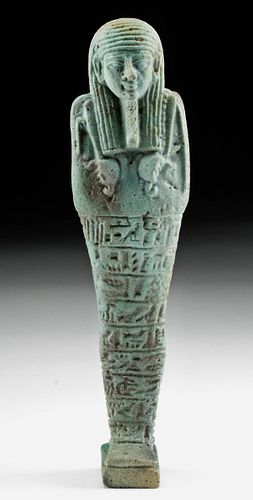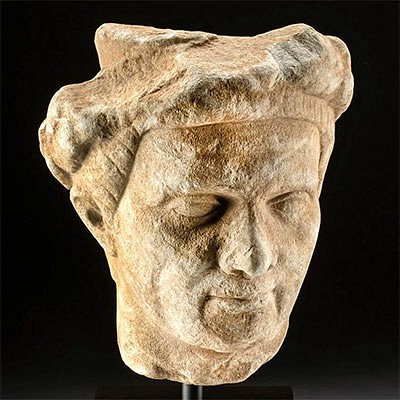Superb Egyptian Faience Ushabti for Imhotep, TL Tested
Lot 1
About Seller
Artemis Fine Arts
686 S Taylor Ave, Ste 106
Louisville, CO 80027
United States
Selling antiquities, ancient and ethnographic art online since 1993, Artemis Gallery specializes in Classical Antiquities (Egyptian, Greek, Roman, Near Eastern), Asian, Pre-Columbian, African / Tribal / Oceanographic art. Our extensive inventory includes pottery, stone, metal, wood, glass and textil...Read more
Estimate:
$6,000 - $9,000
Absentee vs Live bid
Two ways to bid:
- Leave a max absentee bid and the platform will bid on your behalf up to your maximum bid during the live auction.
- Bid live during the auction and your bids will be submitted real-time to the auctioneer.
Bid Increments
| Price | Bid Increment |
|---|---|
| $0 | $25 |
| $300 | $50 |
| $1,000 | $100 |
| $2,000 | $250 |
| $5,000 | $500 |
| $10,000 | $1,000 |
| $20,000 | $2,500 |
| $50,000 | $5,000 |
| $100,000 | $10,000 |
| $200,000 | $20,000 |
About Auction
By Artemis Fine Arts
Jun 1, 2023
Set Reminder
2023-06-01 10:00:00
2023-06-01 10:00:00
America/New_York
Bidsquare
Bidsquare : Ancient | Asian | Ethno | Native American Art
https://www.bidsquare.com/auctions/artemis-gallery/ancient-asian-ethno-native-american-art-12905
Featuring classical antiquities, ancient, and ethnographic art from cultures encompassing the globe. Egyptian, Greek, Roman, Near Eastern, Asian, Pre-Columbian, Native American, African / Tribal, Oceanic, Spanish Colonial, Fossils, more! All legally acquired, legal to sell. Satisfaction guaranteed. Artemis Fine Arts info@artemisgallery.com
Featuring classical antiquities, ancient, and ethnographic art from cultures encompassing the globe. Egyptian, Greek, Roman, Near Eastern, Asian, Pre-Columbian, Native American, African / Tribal, Oceanic, Spanish Colonial, Fossils, more! All legally acquired, legal to sell. Satisfaction guaranteed. Artemis Fine Arts info@artemisgallery.com
- Lot Description
Ancient Egypt, Late Dynastic Period, 26th Dynasty, ca. 664 to 525 BCE. A fabulous faience ushabti standing with tall, mummiform stature atop an integral rectangular plinth, with the name Imhotep inscribed in the top line of hieroglyphs. The dignified individual presents with a smooth chest, holding a finely detailed pick and hoe in crossed arms, and with a thatched seed bag draped behind the left shoulder. His amicable face exhibits almond-shaped eyes with elongated canthi, a slender nose with delineated nostrils, indented mouth corners, cupped ears, and a plaited false beard, all framed within the striated lappets of his tripartite wig. Nine horizontal bars of inscribed hieroglyphics identify the figure as a man named Imhotep - likely named after the famous architect some 2000 years prior - and gives blessings and commands concurrent with Chapter 6 of the Egyptian Book of the Dead. Size: 1.8" W x 7.4" H (4.6 cm x 18.8 cm)
Ushabti (or shabti) dolls are figures shaped like adult male or female mummies wearing traditional ancient Egyptian headdresses. The ancient Egyptians believed that after they died, their spirits would have to work in the "Field of Reeds" owned by the god of the underworld, Osiris. This meant doing agricultural labor - and it was required by all members of society, from workers to pharaohs. The wealthier nobility in Egyptian society were able to have shabtis made of faience which was typically covered in blue or blue-green glaze like this example; its color was meant to reflect the color of the river Nile both on earth and in the afterlife.
Ushabti were first introduced in the Middle Kingdom as substitutes for the mummy in case it was destroyed. During the Second Intermediate Period inscribed wooden figures called shawabtis (after the Egyptian word for wood, shawab) began to be placed in tombs. During the New Kingdom, ushabti assumed a new role as servant figures for the deceased. They were now depicted with agricultural equipment. By the Third Intermediate Period, the number of shabti placed in the tomb was set at 401 (365 workers and 36 overseers). During the Late Period the tomb figures became known as ushabtis ('answerers'), these figures represented servants who would magically answer when called upon to perform agricultural duties for the Pharaoh (in the form of Osiris) in the afterlife. Their main function was to ensure the individual's comfort and freedom from daily labor in the next life.
This piece has been tested using thermoluminescence (TL) analysis and has been found to be ancient and of the period stated. A full printed and bound report will accompany the item upon purchase.
Provenance: ex-John Hurter collection, Palm Springs, California, USA, prior to 1995
All items legal to buy/sell under U.S. Statute covering cultural patrimony Code 2600, CHAPTER 14, and are guaranteed to be as described or your money back.
A Certificate of Authenticity will accompany all winning bids.
We ship worldwide and handle all shipping in-house for your convenience.
#178926Minor pitting, fading to glaze pigment, and softening to some finer details and hieroglyphs, otherwise intact and excellent. Nice preservation to most hieroglyphs. TL drill holes beneath base and above dorsal pillar.Condition
- Shipping Info
-
All shipping is handled in-house for your convenience. Your invoice from Artemis Gallery will include shipping calculation instructions. If in doubt, please inquire BEFORE bidding for estimated shipping costs for individual items.
-
- Buyer's Premium



 EUR
EUR CAD
CAD AUD
AUD GBP
GBP MXN
MXN HKD
HKD CNY
CNY MYR
MYR SEK
SEK SGD
SGD CHF
CHF THB
THB















